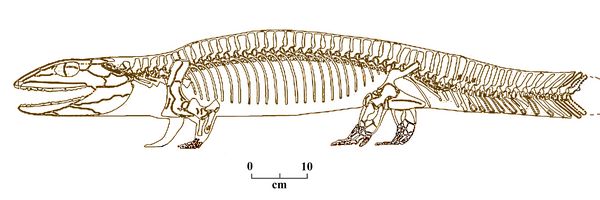Athena Review Image Archive ™
Proterogyrinus scheelei

Proterogyrinus scheelei (after Romer).
Proterogyrinus
was an relatively large amphibian found in Scotland, the UK, and
West Virginia, dating to the Serpukhovian (Pennsylvanian, or
mid-Carboniferous period) at ca. 331-323 mya. The type species, P. scheelei, was named
by Alfred Romer in 1970, and the taxon was further described by Holmes in 1984. Proterogyrinus means "earlier wanderer" or
"earlier tadpole." It belonged to the order Embolomeri, and the Family Protogyrinidae.
Proterogyrinus had a semi-elongated skull, taller than that of other early
tetrapods such as colosteids and temnospondyls, and resembling those of other embolomeres such as Archeria. Proterogyrinus grew up to 2 1/2 m in length, similar in
size and shape to other large amphibians such as Crassigyrinus
and Eryops.
Strong limbs with several fully-ossified ankle and wrist bones allowed Proterogyrinus to walk and hunt on land. However, the presence of lateral line grooves and otic notches which likely held spiracles indicate they retained aquatic, early tetrapod traits. Their long, high tail was used in swimming, and their eye position, high on the skull, suggests a viewpoint just above the water surface.
References:
Holmes, R. 1984 The Carboniferous Amphibian Proterogyrinus scheelei Romer, and the Early Evolution of Tetrapods". Philosophical Transactions of the Royal Society of London. Series B, Biological Sciences. 306 (1130): 431–524.
Romer,
A.S. 1970. A new anthracosaurian labyrinthodont,
Proterogyrinus scheelei, from the Lower Carboniferous. Kirtlandia. 10:
1–16.
Copyright © 1996-2020 Rust Family Foundation (All Rights Reserved).